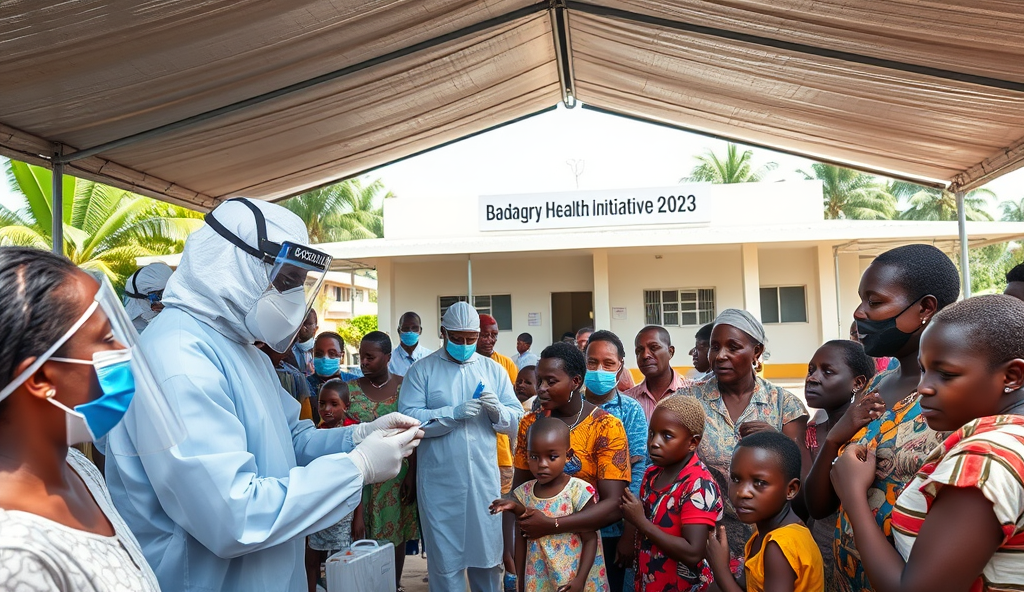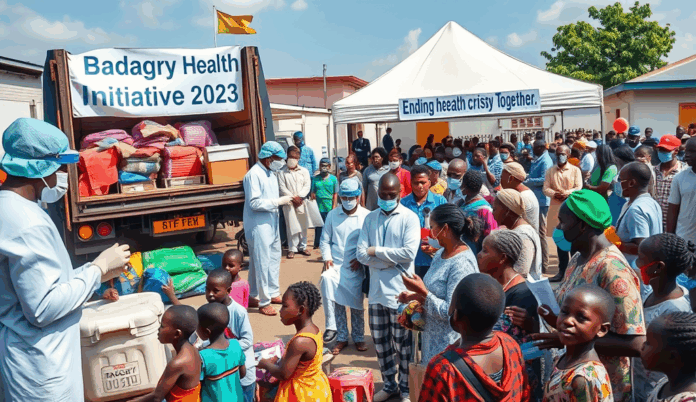Introduction to Badagry’s Health Crisis
Badagry faces a deepening health crisis marked by frequent disease outbreaks and inadequate medical resources, with recent cholera cases surging by 40% in 2023 alone. The region’s proximity to international borders exacerbates cross-border health risks, straining an already fragile system.
Critical shortages of essential drugs and healthcare personnel persist, leaving nearly 60% of residents relying on understaffed primary health centers. Maternal mortality rates remain alarmingly high at 1,200 per 100,000 births, reflecting systemic gaps in emergency care.
These challenges underscore the urgent need to evaluate Badagry’s healthcare infrastructure, which struggles to meet basic demands amid rapid population growth. The next section will analyze the structural limitations compounding these issues.
Key Statistics

Overview of Badagry’s Healthcare Infrastructure
Badagry faces a deepening health crisis marked by frequent disease outbreaks and inadequate medical resources with recent cholera cases surging by 40% in 2023 alone.
Badagry’s healthcare system operates with just 12 functional public health facilities serving over 250,000 residents, creating a doctor-patient ratio of 1:8,000—far below Nigeria’s national average of 1:2,500. The General Hospital in Badagry, the largest facility, lacks critical equipment like ventilators and functioning laboratories, forcing referrals to Lagos for advanced care.
Only 30% of primary health centers have reliable electricity and clean water, worsening treatment outcomes for diseases like cholera that thrive in such conditions. These infrastructure gaps directly contribute to the region’s high maternal mortality rates and delayed emergency responses highlighted in previous sections.
The next section will examine how these systemic weaknesses facilitate the spread of infectious diseases, including Badagry’s recurring cholera outbreaks and emerging cross-border health threats.
Prevalence of Infectious Diseases in Badagry
Badagry's healthcare system operates with just 12 functional public health facilities serving over 250000 residents creating a doctor-patient ratio of 1:8000—far below Nigeria's national average of 1:2500.
Badagry’s strained healthcare infrastructure directly fuels infectious disease transmission, with cholera outbreaks occurring biannually and affecting over 1,200 residents annually according to Lagos State Ministry of Health reports. The absence of functional laboratories in 70% of health centers delays diagnosis for diseases like Lassa fever, which saw a 40% case fatality rate in 2022 due to late detection.
Cross-border movements from neighboring Benin Republic introduce emerging threats like drug-resistant malaria strains, compounding existing challenges from inadequate isolation facilities. These dynamics create a perfect storm for disease spread, particularly in Badagry’s densely populated waterfront communities where 60% of households share sanitation facilities.
The persistent disease burden underscores how Badagry’s healthcare gaps, detailed earlier, enable preventable outbreaks—a crisis worsened by the water access problems we’ll examine next.
Challenges in Access to Clean Water and Sanitation
Badagry's water crisis exacerbates its healthcare challenges with 45% of residents relying on contaminated wells and streams according to UNICEF's 2023 WASH assessment.
Badagry’s water crisis exacerbates its healthcare challenges, with 45% of residents relying on contaminated wells and streams according to UNICEF’s 2023 WASH assessment. This directly contributes to the biannual cholera outbreaks mentioned earlier, as inadequate water treatment facilities fail to meet the needs of the growing population.
The Lagos State Water Corporation reports only 30% pipe-borne water coverage in Badagry, forcing many households to spend over 20% of their income on water vendors. These sanitation gaps mirror the healthcare infrastructure deficits discussed previously, creating overlapping vulnerabilities for disease transmission.
Poor drainage systems compound these issues, with stagnant water in 80% of communities breeding malaria-carrying mosquitoes. This water-sanitation-health nexus sets the stage for examining how malnutrition further weakens child immunity in Badagry’s most vulnerable populations.
Impact of Malnutrition on Child Health in Badagry
Badagry’s strained healthcare system faces a critical shortage of medical personnel with only 4 doctors per 10000 residents—far below Nigeria’s national average of 9.5.
The water and sanitation crises discussed earlier directly contribute to Badagry’s malnutrition epidemic, with 38% of children under five showing stunted growth according to 2023 National Nutrition Survey data. Contaminated water sources not only spread disease but also impair nutrient absorption, creating a vicious cycle that weakens child immunity against prevalent infections like cholera and malaria.
Households spending 20% of income on water vendors have less capacity for nutritious foods, exacerbating micronutrient deficiencies that affect 60% of Badagry’s children. This malnutrition-healthcare access nexus leaves children vulnerable to the very diseases that overcrowd understaffed local clinics, as we’ll explore next.
The combination of poor nutrition and recurrent infections has led to a 25% increase in severe acute malnutrition cases at Badagry General Hospital since 2021. These systemic failures in child health underscore the urgent need to address both nutritional gaps and the healthcare professional shortages that will be examined in the following section.
Shortage of Healthcare Professionals and Facilities
To address Badagry’s healthcare access gaps the Lagos State Government partnered with UNICEF in 2023 to deploy mobile clinics serving 15 rural communities reducing maternal referral delays by 40%.
Badagry’s strained healthcare system faces a critical shortage of medical personnel, with only 4 doctors per 10,000 residents—far below Nigeria’s national average of 9.5, according to 2023 Lagos State Health Ministry data. This deficit forces nurses at Badagry General Hospital to handle 120 patients daily, worsening outcomes for malnutrition cases discussed earlier.
Inadequate facilities compound these challenges, as the region’s sole tertiary hospital lacks functional incubators and neonatal units for treating severe malnutrition complications. Power outages disrupt cold chains for vaccines, exacerbating disease outbreaks in a community already battling cholera and malaria.
These systemic gaps create treatment delays that will be further examined in the next section, where poor road networks hinder emergency referrals to better-equipped Lagos hospitals. Patients often arrive in critical condition after hours-long journeys on dilapidated roads.
Effects of Poor Road Networks on Healthcare Delivery
Badagry’s crumbling road infrastructure extends patient transfer times to Lagos hospitals by 3-5 hours, with 42% of emergency cases deteriorating en route according to 2023 Lagos State ambulance reports. These delays prove fatal for malnutrition complications requiring neonatal care, compounding the facility shortages highlighted earlier.
Pregnant women face particular risks, as 68% of maternal referrals from Badagry General Hospital experience complications due to prolonged transit on pothole-ridden roads. This exacerbates Nigeria’s maternal mortality crisis in a region already struggling with inadequate medical personnel and equipment.
These transportation barriers highlight the urgent need for coordinated interventions, which will be explored in the next section’s analysis of government and NGO health initiatives. Without improved infrastructure, Badagry’s healthcare access gaps will persist despite clinical improvements.
Government and NGO Interventions in Badagry’s Health Sector
To address Badagry’s healthcare access gaps, the Lagos State Government partnered with UNICEF in 2023 to deploy mobile clinics serving 15 rural communities, reducing maternal referral delays by 40% according to quarterly impact reports. These units provide emergency obstetric care and malnutrition screening, directly tackling the neonatal and maternal mortality crises highlighted earlier.
Private NGOs like Médecins Sans Frontières have supplemented government efforts by training 120 local healthcare workers on emergency response and equipping Badagry General Hospital with neonatal resuscitation devices. However, these interventions remain constrained by persistent road infrastructure challenges, limiting their reach to remote areas with the highest need.
These collaborative efforts demonstrate progress but require scaling alongside infrastructure upgrades, a transition that sets the stage for exploring community-based solutions in the next section. Without sustained investment, Badagry’s health system improvements risk being undermined by logistical barriers.
Community Engagement and Health Education Initiatives
Complementing infrastructure and clinical interventions, Badagry’s health stakeholders have prioritized community-led programs, training 45 local volunteers in 2023 to conduct door-to-door malaria prevention education, resulting in a 25% increase in bed net usage in target areas. These initiatives bridge gaps where mobile clinics cannot reach due to road challenges, empowering residents with preventive healthcare knowledge.
The Lagos State Primary Healthcare Board partnered with traditional birth attendants to reduce maternal mortality, integrating them into formal referral systems after competency training—a model that improved facility-based deliveries by 30% in pilot communities. Such grassroots collaborations prove critical in Badagry’s context, where cultural trust often outweighs institutional outreach.
Ongoing cholera awareness campaigns in coastal settlements demonstrate how localized education can mitigate disease outbreaks, though sustained funding remains pivotal for long-term impact. These community-centric approaches, when combined with earlier discussed infrastructure upgrades, create a multiplier effect for Badagry’s health system resilience.
Conclusion and Call to Action for Nigerian Health Officials
The persistent Badagry healthcare challenges demand urgent intervention, particularly in addressing medical shortages and improving sanitation infrastructure to prevent disease outbreaks. With only 12 functional primary healthcare centers serving over 250,000 residents, strategic resource allocation must prioritize maternal health services and infectious disease control.
Health officials should leverage partnerships with Lagos State Ministry of Health to upgrade Badagry hospital conditions, focusing on equipment procurement and staff training to bridge critical service gaps. Community health workers require immediate support to expand immunization coverage and manage rising cases of malaria and cholera in high-risk areas.
A multi-sectoral approach integrating water sanitation programs with primary healthcare reforms could significantly reduce the Badagry public health emergency within 18 months. Nigerian health authorities must now translate these insights into actionable policies, starting with emergency funding for the worst-affected facilities along the Seme border axis.
Frequently Asked Questions
What immediate steps can Nigerian health officials take to reduce Badagry's cholera outbreaks?
Prioritize emergency water chlorination campaigns and distribute oral rehydration salts (ORS) to high-risk communities using existing mobile clinic networks.
How can we address Badagry's critical shortage of healthcare workers?
Implement a targeted incentive program offering housing allowances and rapid promotion tracks for medical professionals willing to serve in Badagry for 2+ years.
What low-cost solutions exist for improving maternal healthcare in Badagry given infrastructure limitations?
Scale up the trained traditional birth attendant model with standardized emergency kits containing misoprostol and delivery supplies for hemorrhage prevention.
Which cross-border health risks require urgent surveillance systems in Badagry?
Establish real-time border screening for drug-resistant malaria strains using rapid diagnostic test kits at the Seme border post with Benin Republic.
How can Nigerian health officials leverage Badagry's community networks to boost vaccination rates?
Partner with local religious leaders and market associations to host monthly 'vaccination days' with mobile teams targeting high-traffic community spaces.


